

How to Tessellate: Circles. Tessellation Artist. Mathematics and Art come together!
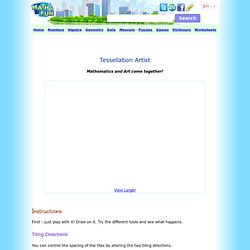
First - just play with it! Draw on it. Try the different tools and see what happens. Tiling Directions You can control the spacing of the tiles by altering the two tiling directions. Try tiling in one direction only: Now tile in two directions: Now try differemt numbers, pressing "Re-Tile" after each change to see the effect. Polygons You can draw regular polygons using the polygon tool. Nudge and Undo After adding a shape, you can "Nudge" it into place, or adjust its size.
What Can You Make? You can make all kinds of interesting patterns! Art and Science: Art, Maths and the Universe. Zac Kenton discusses the mathematical basis of the great artist M.C.

Escher M.C. Escher is famous for his mathematical artwork, using tessellating shapes, warped perspectives and varying geometries. Www.willamette.edu/arts/hfma/pdf/teacher_guides/Toi_Maori.pdf. Tessellating Art. Specific Learning Outcomes: alter polygons to create unique shapes that tessellate describe the reflection or rotational symmetry of a shape or tessellation Description of mathematics: This unit is built around the famous artist Maurits Cornelius Escher.
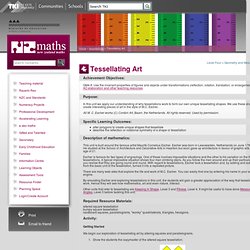
Escher was born in Leeuwarden, Netherlands on June 17th, 1898. He studied at the School of Architecture and Decorative Arts in Haarlem but soon gave up architecture in favour of graphic arts at the age of 21. Escher is famous for two types of engravings. There are many web-sites that explore the life and work of M.C. By emulating Escher and exploring tessellations in this unit, the students will gain a greater appreciation of the way that tessellations work. Other units that refer to tessellating are Keeping in Shape, Level 3 and Fitness, Level 4.
Required Resource Materials: altered square tessellation bumpy square tessellation cardboard squares, parallelograms, "wonky" quadrilaterals, triangles, hexagons. Tessellating Art. Tessellating Tiles. Specific Learning Outcomes: create simple tessellations involving squares and dominoes identify the repeating element(s) in simple tessellations involving squares and dominoes Description of mathematics: This unit is about tessellations, that is, patterns of identical shapes that cover a plane without gaps or overlaps.
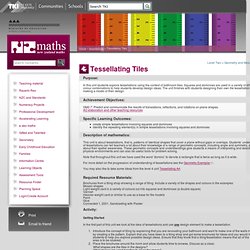
Students’ understanding of tessellations can tell teachers a lot about their knowledge of a range of geometric concepts, including angle and symmetry, and about their spatial awareness. These geometric concepts and understandings give students a means of interpreting and describing physical environments and can also be useful tools for problem solving. Note that throughout this unit we have used the word ‘domino’ to denote a rectangle that is twice as long as it is wide. For more detail on the progression of understanding of tessellations see the Geometry Exemplar. You may also like to take some ideas from the level 4 unit Tessellating Art.
Required Resource Materials: Varnish. Math Antics - Polygons. What’s Regular About Tessellations? Preparing for the Lesson It may be helpful for you to be familiar with the regular and semi-regular tessellations prior to teaching this lesson.
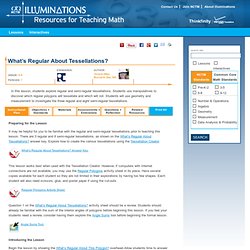
There are 3 regular and 8 semi-regular tessellations, as shown on the What’s Regular About Tessellations? Answer key. Explore how to create the various tessellations using the Tessellation Creator. This lesson works best when used with the Tessellation Creator. Question 1 on the What’s Regular About Tessellations? Introducing the Lesson Begin the lesson by showing the What’s Regular About This Polygon? There are a couple of ways to show students the answer to Question 3: Select a vertex and draw the two diagonals from that vertex. Student Exploration Distribute one What’s Regular About Tessellations? Tessellation Creator. Tessellation Creator. Tantalizing Tesselations!! Integration This unit integrates math with language arts and arts education.

Throughout the activities in this unit, the students are asked to respond to the concept of tessellations. They will write definitions and assess how well their group worked together. In addition, we have exposed the students to tessellations in the environment, such as interior design. If one can locate some prints by M.C. This mathematical topic can also be explored in other subjects. CELs Communication - students will communicate their understanding of the different tessellation concepts in written form. Numeracy - Students will engage in problem solving as they discover the different ways one can tessellate polygons from the geoblocks, and how to tessellate a shape using slide, rotation, and reflection techniques. Personal Social Values and Skills - Students will work cooperatively and contribute positively in the group learning activities.
Grouping Materials Evaluation Activity 1: Activity 2. Totally Tessellated: Site Map. As of July 1, 2013 ThinkQuest has been discontinued.
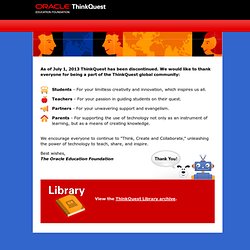
We would like to thank everyone for being a part of the ThinkQuest global community: Students - For your limitless creativity and innovation, which inspires us all. Teachers - For your passion in guiding students on their quest. Partners - For your unwavering support and evangelism. Parents - For supporting the use of technology not only as an instrument of learning, but as a means of creating knowledge. We encourage everyone to continue to “Think, Create and Collaborate,” unleashing the power of technology to teach, share, and inspire. Best wishes, The Oracle Education Foundation. Totally Tessellated: Site Map.